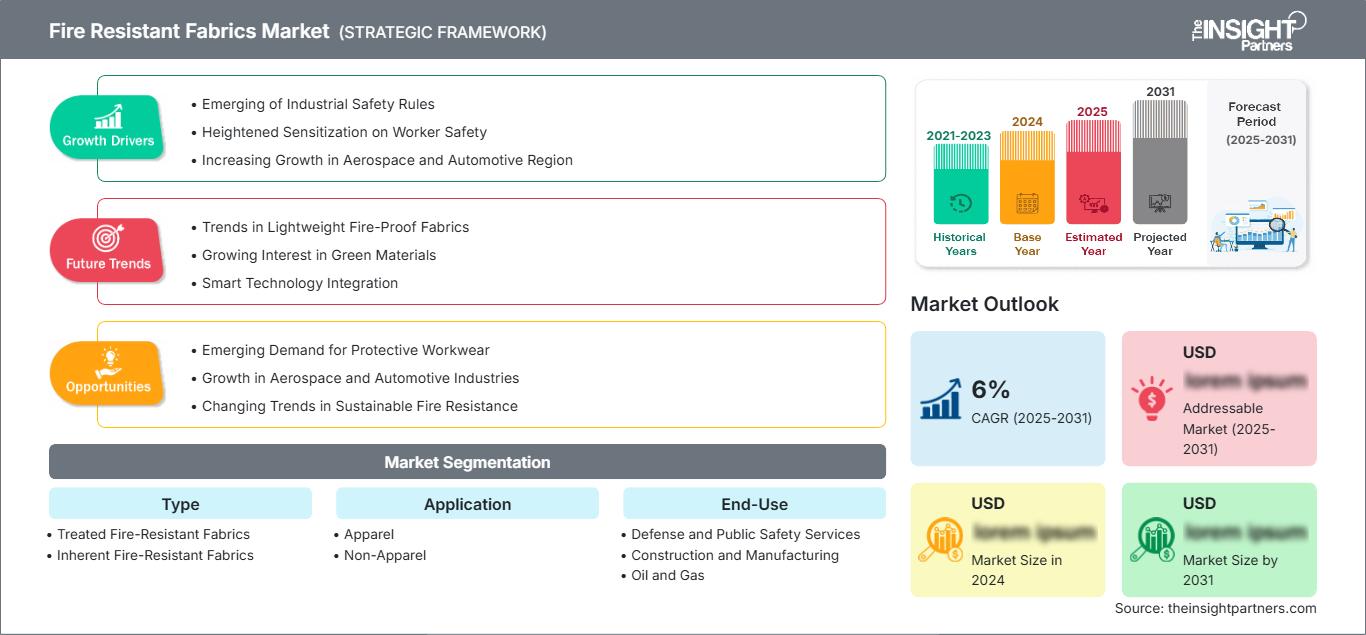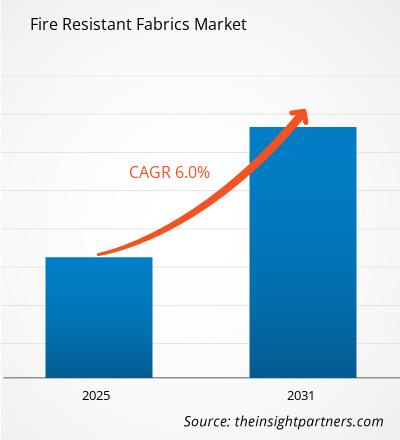Si prevede che il mercato dei tessuti ignifughi registrerà un CAGR del 6% dal 2025 al 2031, con una dimensione del mercato in espansione da XX milioni di dollari nel 2024 a XX milioni di dollari entro il 2031.
Il mercato dei tessuti ignifughi comprende l'analisi per tipologia (tessuti ignifughi trattati, tessuti ignifughi intrinseci); applicazione (abbigliamento, non abbigliamento); uso finale (servizi di difesa e sicurezza pubblica, edilizia e produzione, petrolio e gas, automotive e trasporti, altri) e area geografica (Nord America, Europa, Asia-Pacifico, Medio Oriente e Africa, Sud e Centro America). I tessuti ignifughi sono utilizzati principalmente in numerose applicazioni, come uniformi antincendio, trasporti, abbigliamento da lavoro, forze dell'ordine e arredamento residenziale e commerciale. Un costante miglioramento delle tecnologie, unito alle severe normative imposte dal governo, ha portato a un ulteriore aumento dell'uso di tessuti ignifughi in vari settori industriali.
Scopo del rapporto
Il rapporto "Fire Resistant Fabrics Market" di The Insight Partners mira a descrivere il panorama attuale e la crescita futura, i principali fattori trainanti, le sfide e le opportunità. Ciò fornirà spunti di riflessione a vari stakeholder aziendali, come:
- Fornitori/Produttori di tecnologia: per comprendere le dinamiche di mercato in evoluzione e conoscere le potenziali opportunità di crescita, consentendo loro di prendere decisioni strategiche informate.
- Investitori: per condurre un'analisi completa delle tendenze in merito al tasso di crescita del mercato, alle proiezioni finanziarie di mercato e alle opportunità esistenti lungo la catena del valore.
- Enti di regolamentazione: per regolamentare le politiche e le attività di controllo sul mercato con l'obiettivo di ridurre al minimo gli abusi, preservare la fiducia degli investitori e sostenere l'integrità e la stabilità del mercato.
Tipo di segmentazione del mercato dei tessuti ignifughi
- Tessuti ignifughi trattati
- Tessuti ignifughi intrinseci
Applicazione
- Abbigliamento
- Non abbigliamento
Uso finale
- Servizi di difesa e sicurezza pubblica
- Edilizia e produzione
- Petrolio e gas
- Automotive e trasporti
Geografia
- Nord America
- Europa
- Asia-Pacifico
- Sud e Centro America
- Medio Oriente e Africa
Potrai personalizzare gratuitamente qualsiasi rapporto, comprese parti di questo rapporto, o analisi a livello di paese, pacchetto dati Excel, oltre a usufruire di grandi offerte e sconti per start-up e università
Mercato dei tessuti ignifughi: Approfondimenti strategici

-
Ottieni le principali tendenze chiave del mercato di questo rapporto.Questo campione GRATUITO includerà l'analisi dei dati, che vanno dalle tendenze di mercato alle stime e alle previsioni.
Fattori della crescita del mercato dei tessuti ignifughi
- Emergenza di norme di sicurezza industriale: la domanda di tessuti ignifughi è in aumento con l'aumento delle normative di sicurezza in settori come quello manifatturiero, petrolifero e del gas e aerospaziale. I tessuti ignifughi sono richiesti per indumenti protettivi, isolanti e attrezzature per soddisfare rigorosi standard antincendio e per garantire la sicurezza delle persone in ambienti di lavoro pericolosi.
- Maggiore sensibilizzazione sulla sicurezza dei lavoratori: questa consapevolezza ha portato a una maggiore consapevolezza della sicurezza dei lavoratori nella maggior parte dei settori ad alto rischio. Di conseguenza, ha alimentato la necessità di tessuti ignifughi utilizzati in indumenti protettivi, come uniformi, guanti e tute, per i lavoratori che ora sono meglio protetti dai rischi di incendio in settori come l'edilizia e le costruzioni o l'energia.
- Crescita crescente nel settore aerospaziale e automobilistico: questa spinta dei produttori aeronautici e automobilistici verso una maggiore sicurezza e prestazioni è ciò che crea realmente la domanda di tessuti ignifughi. È utilizzato nell'isolamento, nei rivestimenti dei sedili e in altri componenti protettivi utilizzati in veicoli e aeromobili per migliorare gli standard di sicurezza antincendio e la conformità alle normative.
Tendenze future del mercato dei tessuti ignifughi
- Tendenze nei tessuti ignifughi leggeri: in particolare, i tessuti ignifughi più leggeri e confortevoli sono di tendenza sul mercato. I produttori stanno perseguendo lo sviluppo di tali materiali per la massima protezione con il minimo peso, un maggiore comfort e una migliore mobilità in settori come la lotta antincendio, l'edilizia e l'aerospaziale, senza compromettere la sicurezza.
- Crescente interesse per i materiali ecologici: c'è una crescente tendenza per i materiali ecologici nei tessuti ignifughi. I produttori inizieranno presto a ricercare possibilità utilizzando fibre riciclabili e tecnologie di finitura ignifughe naturali, oltre a raggiungere la soglia di sicurezza antincendio per soddisfare la crescente domanda del settore di prodotti ecosostenibili in settori come la moda e l'abbigliamento protettivo.
- Integrazione delle tecnologie intelligenti: la previsione dei cambiamenti nel mercato dei tessuti ignifughi si basa sugli sviluppi legati alle tecnologie intelligenti. Tessuti come quelli dotati di sensori o rivestimenti speciali avanzati saranno in grado di rilevare calore o fuoco e fornire altre forme di protezione. Queste innovazioni promettono di apportare cambiamenti concreti nell'abbigliamento antincendio.
Opportunità di mercato per i tessuti ignifughi
- Emergente domanda di indumenti da lavoro protettivi: vi è una crescente opportunità per i tessuti ignifughi negli indumenti da lavoro protettivi, poiché settori come quello petrolifero e del gas, minerario ed edile attribuiscono sempre maggiore importanza alla sicurezza dei dipendenti. I tessuti ignifughi diventano dispositivi di protezione individuale (DPI) di base, aumentando così la domanda di materiali durevoli e ad alte prestazioni in ambienti di lavoro pericolosi.
- Crescita nei settori aerospaziale e automobilistico: i tessuti ignifughi offrono grandi opportunità nei settori aerospaziale e automobilistico in rapida crescita. Gli standard di sicurezza antincendio sono piuttosto rigidi per quanto riguarda l'isolamento, i rivestimenti e i dispositivi di protezione individuale nella produzione aeronautica e automobilistica. Con la crescente attenzione alla sicurezza dei passeggeri e il rispetto più rigoroso delle normative, la domanda di tali materiali si prevede in crescita in futuro.
- Tendenze in evoluzione nella resistenza al fuoco sostenibile: l'ambito delle opportunità offerte dai tessuti ignifughi, in linea con l'attuale paradigma in evoluzione, è quello dello sviluppo di soluzioni ecosostenibili. I tessuti ignifughi riciclati o biodegradabili offrono un valore aggiunto al consumatore attento all'ambiente, in considerazione dell'attuale tendenza verso l'uso di materiali sostenibili.
Mercato dei tessuti ignifughi
Le tendenze regionali e i fattori che influenzano il mercato dei tessuti ignifughi durante il periodo di previsione sono stati ampiamente spiegati dagli analisti di The Insight Partners. Questa sezione illustra anche i segmenti e la distribuzione geografica del mercato dei tessuti ignifughi in Nord America, Europa, Asia-Pacifico, Medio Oriente e Africa, America Meridionale e Centrale.
Ambito del rapporto di mercato sui tessuti ignifughi
| Attributo del rapporto | Dettagli |
|---|---|
| Dimensioni del mercato in 2024 | US$ XX million |
| Dimensioni del mercato per 2031 | US$ XX Million |
| CAGR globale (2025 - 2031) | 6% |
| Dati storici | 2021-2023 |
| Periodo di previsione | 2025-2031 |
| Segmenti coperti |
By Tipo
|
| Regioni e paesi coperti |
Nord America
|
| Leader di mercato e profili aziendali chiave |
|
Densità degli operatori del mercato dei tessuti ignifughi: comprendere il suo impatto sulle dinamiche aziendali
Il mercato dei tessuti ignifughi è in rapida crescita, trainato dalla crescente domanda da parte degli utenti finali, dovuta a fattori quali l'evoluzione delle preferenze dei consumatori, i progressi tecnologici e una maggiore consapevolezza dei vantaggi del prodotto. Con l'aumento della domanda, le aziende stanno ampliando la propria offerta, innovando per soddisfare le esigenze dei consumatori e sfruttando le tendenze emergenti, alimentando ulteriormente la crescita del mercato.

- Ottieni il Mercato dei tessuti ignifughi Panoramica dei principali attori chiave
Punti di forza
- Copertura completa: il rapporto copre in modo completo l'analisi di prodotti, servizi, tipologie e utenti finali del mercato dei tessuti ignifughi, fornendo un panorama olistico.
- Analisi di esperti: il rapporto è compilato sulla base della conoscenza approfondita di esperti e analisti del settore.
- Informazioni aggiornate: il rapporto garantisce rilevanza aziendale grazie alla sua copertura di informazioni recenti e tendenze dei dati.
- Opzioni di personalizzazione: questo rapporto può essere personalizzato per soddisfare le esigenze specifiche del cliente e adattarsi in modo appropriato alle strategie aziendali.
Il rapporto di ricerca sul mercato dei tessuti ignifughi può, quindi, aiutare a guidare il percorso di decodificazione e comprensione dello scenario del settore e delle prospettive di crescita. Sebbene possano esserci alcune preoccupazioni valide, i vantaggi complessivi di questo rapporto tendono a superare gli svantaggi.
- Analisi storica (2 anni), anno base, previsione (7 anni) con CAGR
- Analisi PEST e SWOT
- Valore/volume delle dimensioni del mercato - Globale, Regionale, Nazionale
- Industria e panorama competitivo
- Set di dati Excel
Report recenti
Testimonianze
Motivo dell'acquisto
- Processo decisionale informato
- Comprensione delle dinamiche di mercato
- Analisi competitiva
- Analisi dei clienti
- Previsioni di mercato
- Mitigazione del rischio
- Pianificazione strategica
- Giustificazione degli investimenti
- Identificazione dei mercati emergenti
- Miglioramento delle strategie di marketing
- Aumento dell'efficienza operativa
- Allineamento alle tendenze normative






















 Ottieni un campione gratuito per - Mercato dei tessuti ignifughi
Ottieni un campione gratuito per - Mercato dei tessuti ignifughi